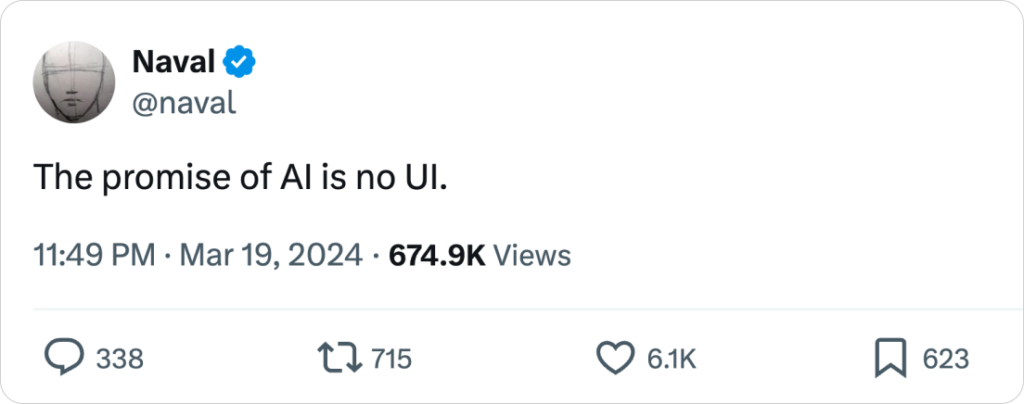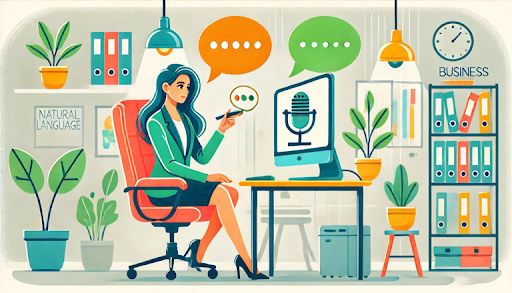The promise of AI is no UI

@naval tweeted this one simple sentence, declaring that the promise of artificial intelligence (AI) is no user interface (UI). But what does he mean by that, exactly? Is he suggesting a move away from the graphical user interfaces (GUIs) we’ve been using since the Apple MacIntosh? That we will start using our voice to speak to a computer, à la War Games? Or maybe there’s no UI anymore, because AI will replace the user?
It got me thinking: What will the impact of AI be on user interfaces, especially in enterprise software packages like BSS?
Just as GUIs changed human-to-computer interaction dramatically in the 1980s, AI will have a profound effect on how we interact with computers. In the short-term, AI will at least identify patterns and trends, predict your behavior and goals, give you personalized responses, and make real-time adjustments to your experience. Apple’s recent demos at WWDC24 provided a glimpse into our AI-driven future. This is not just about smarter phones; we are moving to where the interface becomes nearly invisible, and the system anticipates and responds to user needs intuitively. By this fall, millions of YOUR subscribers will dive head-first into an immersive AI mobile experience, raising consumers’ expectations for each interaction around the mobile phone.
Is telco ready for that? Looking at the state of the industry’s software, my guess is NOT. EVEN. CLOSE. But fasten your seatbelts, telco execs, because we’re at the beginning of a seismic shift. If you didn’t already have a ton on your plate, you’re going to have to go through a full “UI” refresh of all your systems, ASAP.

Zero UI in enterprise telco software
I agree with Naval: I think we are headed towards “Zero UI”. Zero UI refers to software that is:
- Intuitive to the point that it understands speech and gestures
- Contextual in that it can adapt to a user’s surroundings and situation
- Empathetic in that it can detect a user’s emotional state through tone of voice, facial expression, and biometrics like pupil dilation or pulse
- Inclusive in that it can adjust to accommodate a range of abilities, languages, and cultures
I can think of a few ways Zero UI might come to telco software. The no-brainer example: better customer service. With a legacy system, customers had to contact an operator’s support number, navigate an automated voice menu, wait on hold, and then explain their issue to a human representative who manually looked up their account information to troubleshoot the problem.
With a Zero UI solution, customers can simply say, “My internet is not working” to their smart speaker or mobile device. The AI system immediately identifies the user, detects the issue, and responds, “I see your internet is down. I’ve opened a ticket and dispatched a technician to your location. You’ll receive a text message with the estimated arrival time.”
But let’s take it up a notch. With an AI-centric BSS, a routine process like activating a new customer account and provisioning services might take significantly less time than it does today. Imagine an AI system that automatically retrieves necessary information, configures services, and sends relevant details to the customer. The whole process takes less than five minutes, compared to the old-school approach of “manual” activation through a legacy GUI-based BSS that might take up to 30 minutes or longer, involving multiple screens, potential errors, and manual handoffs.
And of course, my favorite: personalized experiences. An AI-powered BSS can analyze customers’ usage patterns, preferences, and real-time behavior to proactively offer optimized data plans or features, enhancing the subscriber experience and generating additional revenue. A legacy system relying on static customer segments and manual upsell processes will miss these opportunities.
Caveat Emptor
As we move towards a Zero UI future, it’s crucial for telco execs to recognize that traditional RFPs and legacy systems will soon be outdated. Investing in AI-driven solutions is not just a trend; it’s a necessity to stay competitive in a landscape where Zero UI will become the norm. Those old, dusty and crusty RFPs you keep recycling will need to be tossed out the window, with their outdated list of requirements that are no longer relevant. If you’re about to pull the trigger on a new BSS, you might want to pump the brakes on that multi-million dollar investment. You’re at risk of spending millions on something that’ll be rubbish in a few years—UNLESS your chosen vendor has massive AI plans on its roadmap.
Buying a traditional BSS from the likes of Amdocs, Netcracker, CSG, and Ericsson will be money down the toilet when their keyboard-and-mouse-click-driven UIs become obsolete. Will that be in a year or two? Probably not. But in five years, most of the old UI will be gone. In 10 years, it will have disappeared completely. You may not even be done with your digital transformation project for your “new” BSS solution before it’s obsolete!
For traditional BSS vendors in telco, AI requires them to re-think their current business model, which is largely dependent on significant professional services revenue. The new software vendors in telco will be empowering the business person (not the techie) to be able to make changes, design screens, and write code on their own. Bye-bye, CRs! What will Amdocs do now?
Totogi is riding the AI wave
The shift towards Zero UI will redefine how telco companies operate, from customer service to system provisioning and personalized experiences. Embracing AI and preparing for this change is not optional; it’s imperative for future success. At Totogi, where I’m acting CEO, we’re already in the future. This is exactly what we’ve done to design BSS Magic. We started from the ground up with this product, designing it with all the latest tech to enable five different types of generative AI to do the work for you. BSS Magic generates software code automatically to produce the BSS you want in minutes, no engineering expertise required. BSS Magic isn’t just the most innovative BSS out there, it represents a paradigm shift in how we build telco software. And trust me: this is just the beginning.
Totogi is the only company positioned to ride the AI wave. We are on top of this seismic shift, which is a 10 on the Richter Scale for enterprise software. And if your vendors don’t understand that and aren’t embracing it, then you’re working with the wrong team.
Experience the future of BSS at DTW24
The future of telco software is clear: Zero UI powered by AI. Come see it in action at TM Forum’s DTW24-Ignite in Copenhagen from June 18 – 20. Totogi will be demoing BSS Magic in the AWS space, showcasing the future of Zero UI. Want to meet up and explore the possibilities? DM me on LinkedIn or X @TelcoDR and let’s connect. Let’s get your telco ready for the Zero UI future.
Recent Posts

 Get my FREE insider newsletter, delivered every two weeks, with curated content to help telco execs across the globe move to the public cloud.
Get my FREE insider newsletter, delivered every two weeks, with curated content to help telco execs across the globe move to the public cloud.
Listen
While at the Fjord agency, Andy Goodman popularized the “Zero UI” term in 2015.
Watch
DR opened MWC’s second annual MVNO Summit with an epic talk about the AI-powered revolution in telco business support systems (BSS).
Read
AI is transforming telcos’ BSS data, democratizing access to deliver strategic insights, predictive analytics, operational efficiency, and more.
